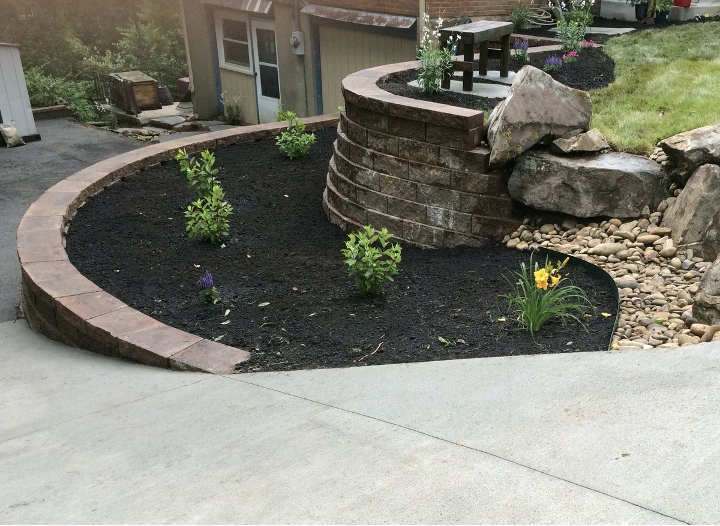Attain a Beautiful Outside Oasis With Thoughtful Steep Hillside Landscape Design Solutions
Changing a steep hill into a fascinating exterior oasis offers one-of-a-kind obstacles that call for cutting-edge landscape design options. By attending to concerns such as erosion control and access, one can produce an unified blend of charm and functionality. Strategies such as terracing, the setup of maintaining wall surfaces, and the choice of native plants play critical functions in this procedure. Furthermore, incorporating water functions can additionally boost the landscape's allure. Comprehending the intricacies of these elements is essential for achieving a genuinely cohesive and inviting environment. What approaches will best suit your hill's certain qualities?
Understanding Steep Hillside Obstacles
Landscape design on high hillsides provides distinct challenges that require mindful factor to consider and calculated planning. The inclination of the terrain can result in issues such as soil disintegration, water overflow, and limited ease of access, every one of which have to be dealt with to produce a functional and cosmetically pleasing outside space.
Among the main interest in steep hillside landscaping is erosion, which can arise from heavy rains or incorrect drainage. This not just impacts plant health but can additionally endanger the stability of the incline. Executing effective disintegration control steps, such as growing deep-rooted vegetation or making use of mulch, is crucial in preserving the honesty of the landscape.

Designing With Terracing Techniques
To reduce the difficulties positioned by steep hills, incorporating terracing techniques can be an effective solution. This design approach changes a sloped landscape right into a collection of level, degree locations, producing a visually striking and functional outdoor room. Terracing not just aids to avoid soil erosion but additionally promotes much better water drainage, which is vital in keeping the wellness of plants and the stability of the hill.
The use of indigenous plants on each degree can improve biodiversity, promote sustainability, and lower upkeep demands. In addition, incorporating paths in between balconies can improve accessibility and motivate expedition of the landscape.
Terraced gardens can offer several purposes, including veggie production, decorative displays, or exterior seating locations. By making use of materials that mix harmoniously with the surrounding atmosphere, the terracing can boost the overall visual appeal of the building. Ultimately, thoughtful terracing changes high hills right into useful, stunning rooms that invite interaction and enjoyment.
Carrying Out Retaining Walls
When encountered with the challenges of steep surface, applying keeping wall surfaces can give both structural support and aesthetic improvement to a landscape. These wall surfaces offer to avoid soil erosion, maintain inclines, and create flat areas for gardening or leisure usage. Steep hill landscaping. By effectively managing water overflow and minimizing dirt activity, keeping walls secure your landscape financial investment while boosting safety and security

Specialist installation is critical to guarantee the longevity i thought about this and performance of keeping wall surfaces. Proper water drainage systems must be incorporated to eliminate hydrostatic pressure, stopping structural failure. Consulting with landscape specialists will make sure that the design lines up with your general vision while sticking to local guidelines.
Choosing Native Plants
Choosing indigenous plants for your landscape design uses countless ecological and visual advantages. Steep hill landscaping. Indigenous plants are adapted to the regional environment and dirt conditions, calling for much less water and upkeep contrasted to non-native species. This versatility not only saves sources but also advertises a healthier environment, as indigenous plants support neighborhood wild animals, consisting of pollinators such as and butterflies
Integrating indigenous flora right into your high hill landscaping can boost dirt stability, reducing disintegration and advertising a balanced environment. Ingrained native plants aid anchor the dirt, making have a peek at this website them ideal for sloped locations. In addition, these plants usually exhibit lively shades and diverse structures, creating an aesthetically appealing landscape that integrates with the surrounding setting.
When picking indigenous plants, consider their growth behaviors, seasonal rate of interest, and compatibility with various other varieties. Organizing plants with comparable water and sunshine needs can cause additional reading a much more cohesive design, while also streamlining upkeep. By selecting native plants, you not only grow a lasting outdoor oasis yet also contribute favorably to the regional biodiversity, making sure that your landscape flourishes for years ahead.
Incorporating Water Attributes
Integrating water features right into your steep hill landscape design can substantially enhance both the visual charm and ecological functionality of the room. The noise of flowing water develops a peaceful atmosphere, while aesthetically, it can act as a prime focus that draws the eye and includes depth to the landscape.
When picking water functions, consider alternatives that complement the all-natural contours of your hill. Waterfalls, for example, can cascade the incline, creating aesthetic interest and advertising healthy drain. Fish ponds can likewise be incorporated into the layout, encouraging regional wild animals and supplying environments for various types.
In addition, the positioning of plants around these features is essential. Indigenous water plants not only improve the elegance of the water function yet also add to its eco-friendly balance by filtering toxins and giving food for regional animals.
Upkeep is another essential variable; ensure that your water function is made for easy upkeep. An effectively constructed feature will need marginal treatment, allowing you to delight in the elegance and tranquility it provides without extreme labor. Eventually, attentively bundled water attributes can transform your steep hill landscape into a captivating outside oasis.
Final Thought
In verdict, changing a steep hillside right into an attractive outside oasis necessitates thoughtful landscape design methods that deal with erosion control and accessibility. The combination of terracing techniques, the implementation of preserving walls, and the selection of indigenous plants are necessary elements of effective layout.